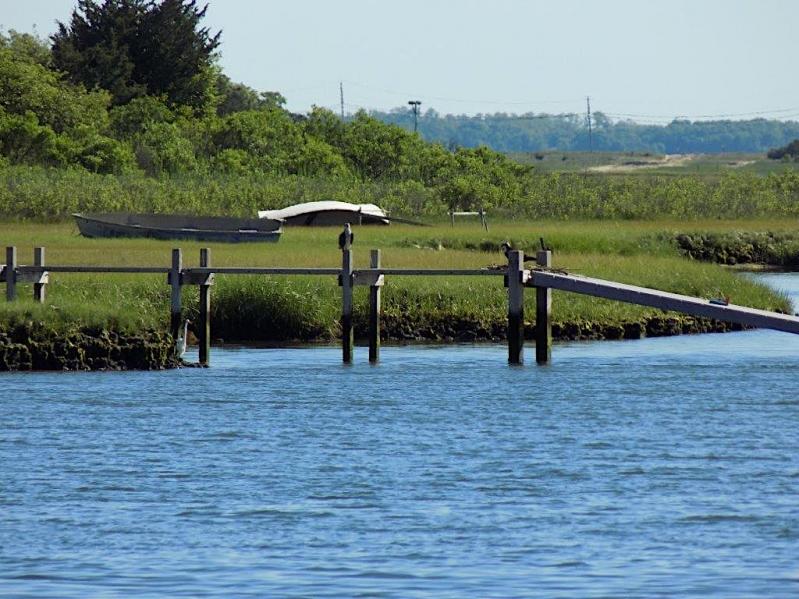A Springs woman drew the attention of the United States Fish and Wildlife Service and the New York State Department of Environmental Conservation after removing what she said was an inactive osprey nest from her dock on Accabonac Harbor in early June.
Ospreys are protected under New York State Law and under the federal Migratory Bird Treaty Act.
Two people witnessed the removal and reported the incident to authorities, according to Jim Grimes, an East Hampton Town trustee. Mr. Grimes said that the property owner, Cindi Crain, had contacted the trustee office complaining about the nest at the end of her dock.
“I saw the lady who I know to be the owner of the dock. She and another young girl kicked and kicked and kicked and rocked the dock and kicked until the nest came apart, piece by piece,” said Dot Field, who lives nearby. “It was destruction and it made me sick. I was shaken.” Ms. Field says she and her husband had been watching the nest for over a month and, “It was certainly not abandoned.”
In an email exchange with the town’s Natural Resources Department, obtained by The Star under the New York State Freedom of Information Law, Ms. Crain said the nest had two eggs in it in mid-May, but that she “was concerned that it was in a vulnerable spot” and had reported it to the Evelyn Alexander Wildlife Center, the Natural Resources Department, the town trustees, and the D.E.C. All had deferred to the Fish and Wildlife Service.
“The nest had been laid in full reach of predators, and would have been unstable rising and falling with the tide on the floating part of my dock,” she wrote on June 5 to Kimberly Shaw, the town’s director of natural resources. “As of Sunday the eggs were no longer there, and the parent ospreys were nowhere to be found. The nest was dry and disintegrating and [Fish and Wildlife Service] rules clearly spell out that nests without eggs or chicks in the nest can be disposed of without a federal permit.”
In her emails with the Natural Resources Department, Ms. Crain, who described herself as a naturalist, said that she had followed the Fish and Wildlife Service rules: “Not touching the nest while it had eggs in it and being fully at liberty to remove it once it was abandoned.”
“People can’t just take it upon themselves to say, ‘I’m an expert,’ “ Ms. Shaw said in a phone call on Tuesday. “An application needs to be made to the U.S.F.W.S. We work very closely with them. They have a presence out here.” She said that as of Monday afternoon the ospreys were busy rebuilding a nest on the dock, despite the presence of newly installed anti-bird devices.
Robyn Bailey, a project leader at Cornell’s NestWatch, a citizen science project focused on nesting birds, said ospreys can be very persistent. “It’s too late for them to rebuild and re-lay this year. They may be replacing their nest for next year. Which is what makes it unfortunate that the first nest was kicked into the water. It could have been used next year. A nest is a resource that the birds have put their energy into. Now they’re having to put their energy into building a new nest. All of our native birds and their nests are protected. You would never want to remove one.”
She said it was possible a predator could have raided the nest at night, but if there were eggs, the ospreys would have been present to try and protect them. “Anything could walk out there. My guess at that location a raccoon or great horned owl would be two reasonable candidates.”
Osprey fledglings are dependent on their parents for 10 to 20 days and then start to fish for themselves for the next eight to 10 weeks, or until the beginning of migration.
“The D.E.C. recommends individuals reach out during the breeding season (March through September) before removing a nest to confirm any nest set for removal is inactive,” a spokesman for the agency said. “Anyone dealing with a problematic active nest should also reach out, as D.E.C. wildlife staff may be able to provide guidance on how to resolve any conflicts. If possible, it is recommended to wait until after September for necessary removals.”
Because of their protected status, the “illegal take” or disturbance of an osprey nest “can result in a fine up to $250, with the possibility of a misdemeanor charge of cruelty to animals under New York State Department of Agriculture and Markets Law. U.S.F.W.S. penalties could be significantly higher for destroying the nest of a protected bird,” the D.E.C. spokesperson said.
Paul Chapelle, the resident agent in charge of New York for the Fish and Wildlife Service, said he had received a complaint but was unable to comment on the matter, since there was an active investigation.
“I’m comfortable with what I did. I was in touch with absolutely everybody when I found the nest,” said Ms. Crain. One option is to give the ospreys a better nesting area. Ms. Crain reached out to First Coastal but the company wanted $7,000 to erect a pole. “It’s cost prohibitive to do that. If the town wants to do that, they own the strip of land, then by all means.”
The D.E.C. encourages anyone with questions about an animal relocation to contact its environmental conservation officers dispatch line at 1-844-DECECOs (1-844-332-3267) for guidance.




